Employee Engagement in Restaurant Businesses
Added on 2022-09-07
27 Pages6770 Words15 Views
Running Head: EMPLOYEE ENGAGEMENT IN RESTAURANT BUSINESSES 1
EMPLOYEE ENGAGEMENT IN MODERN SUCCESSFUL RESTAURANT BUSINESSES
IN THE UNITED STATES
BY
Student Name
EMPLOYEE ENGAGEMENT IN MODERN SUCCESSFUL RESTAURANT BUSINESSES
IN THE UNITED STATES
BY
Student Name
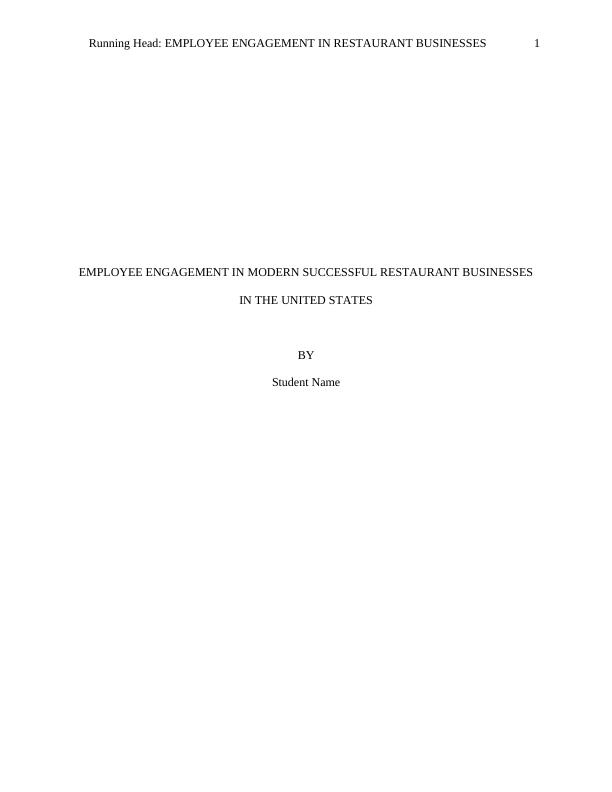
EMPLOYEE ENGAGEMENT IN RESTAURANT BUSINESSES 2
A DISSERTATION PROPOSAL SUBMITTED IN PARTIAL FULFILLMENT OF THE
REQUIREMENTS OF (STUDENT STUDY COURSE) OF (INSTITUTION)
Date
A DISSERTATION PROPOSAL SUBMITTED IN PARTIAL FULFILLMENT OF THE
REQUIREMENTS OF (STUDENT STUDY COURSE) OF (INSTITUTION)
Date
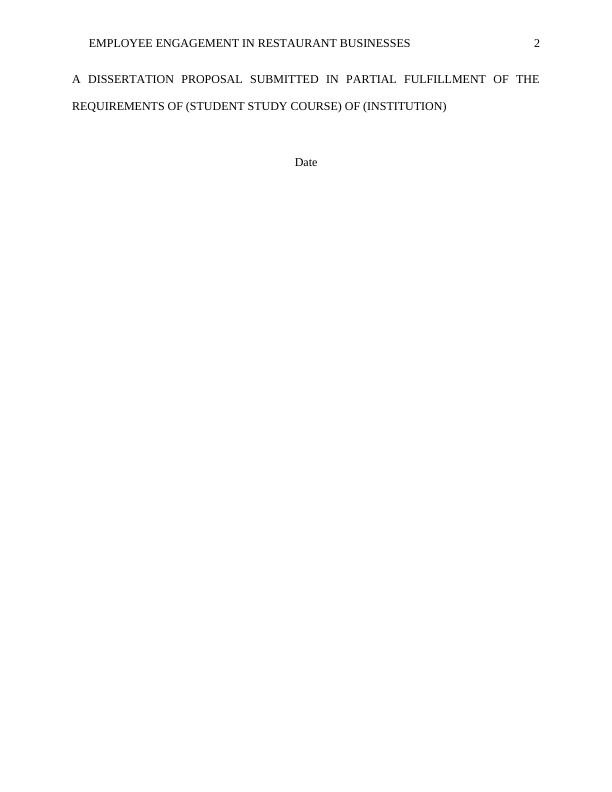
EMPLOYEE ENGAGEMENT IN RESTAURANT BUSINESSES 3
ABSTRACT
There are various factors influencing success of business in modern day economy. Most start up
business fail within their first year of establishment. However, the circle continues as with every
close up, there is always a new start up. There has been discrepancy in which variables help
business to succeed. Amon them is employee engagement in business. This study will accurately
look at the component of employee engagement to determine if a successful restaurant business
is using this strategy. This study seeks to focus on a restaurant in Maryland that has been open
for longer than five years to be able to determine if employee engagement was a helping factor in
the success of the restaurant business. The study requires that one use sample that they are
conversant with thus informing the selection of Maryland. The researcher was informed by
mirroring approach which showed that employee engagement is equivalent to success in business
hence the need test whether it will replicate in the restaurant industry. The study will utilize
employee engagement score card method, surveys and interviews as a way of obtaining primary
data and reviewing recognized existing literature as a way of obtaining secondary data.
ABSTRACT
There are various factors influencing success of business in modern day economy. Most start up
business fail within their first year of establishment. However, the circle continues as with every
close up, there is always a new start up. There has been discrepancy in which variables help
business to succeed. Amon them is employee engagement in business. This study will accurately
look at the component of employee engagement to determine if a successful restaurant business
is using this strategy. This study seeks to focus on a restaurant in Maryland that has been open
for longer than five years to be able to determine if employee engagement was a helping factor in
the success of the restaurant business. The study requires that one use sample that they are
conversant with thus informing the selection of Maryland. The researcher was informed by
mirroring approach which showed that employee engagement is equivalent to success in business
hence the need test whether it will replicate in the restaurant industry. The study will utilize
employee engagement score card method, surveys and interviews as a way of obtaining primary
data and reviewing recognized existing literature as a way of obtaining secondary data.

EMPLOYEE ENGAGEMENT IN RESTAURANT BUSINESSES 4
Table of Contents
CHAPTER ONE: INTRODUCTION..........................................................................................8
Statement of Problem....................................................................................................................9
Purpose of study...........................................................................................................................10
Theoretical Framework...............................................................................................................11
Nature of Study............................................................................................................................13
Research Questions......................................................................................................................14
Hypothesis....................................................................................................................................14
Significance of the Study.............................................................................................................15
Definitions of Key Terms............................................................................................................16
Summary of chapter one.............................................................................................................17
CHAPTER 2: LITERATURE REVIEW..................................................................................19
Theoretical Framework...............................................................................................................20
Factors informing selection of sample and data analysis procedure......................................21
Summary of chapter two.............................................................................................................22
CHAPTER 3 RESEARCH METHOD......................................................................................24
Statement of problem..................................................................................................................24
Research Methodology and Design............................................................................................27
Population and sample materials...............................................................................................27
Operational definition of terms..................................................................................................27
Study procedures.........................................................................................................................28
Data collection and Analysis.......................................................................................................29
Assumption of the study..............................................................................................................29
Limitations of the study...............................................................................................................30
Ethical Assurances.......................................................................................................................30
REFERENCES............................................................................................................................31
LIST OF FIGURES
Figure 1: sample employee score card: source Kumar, 2015........................................................22
Table of Contents
CHAPTER ONE: INTRODUCTION..........................................................................................8
Statement of Problem....................................................................................................................9
Purpose of study...........................................................................................................................10
Theoretical Framework...............................................................................................................11
Nature of Study............................................................................................................................13
Research Questions......................................................................................................................14
Hypothesis....................................................................................................................................14
Significance of the Study.............................................................................................................15
Definitions of Key Terms............................................................................................................16
Summary of chapter one.............................................................................................................17
CHAPTER 2: LITERATURE REVIEW..................................................................................19
Theoretical Framework...............................................................................................................20
Factors informing selection of sample and data analysis procedure......................................21
Summary of chapter two.............................................................................................................22
CHAPTER 3 RESEARCH METHOD......................................................................................24
Statement of problem..................................................................................................................24
Research Methodology and Design............................................................................................27
Population and sample materials...............................................................................................27
Operational definition of terms..................................................................................................27
Study procedures.........................................................................................................................28
Data collection and Analysis.......................................................................................................29
Assumption of the study..............................................................................................................29
Limitations of the study...............................................................................................................30
Ethical Assurances.......................................................................................................................30
REFERENCES............................................................................................................................31
LIST OF FIGURES
Figure 1: sample employee score card: source Kumar, 2015........................................................22
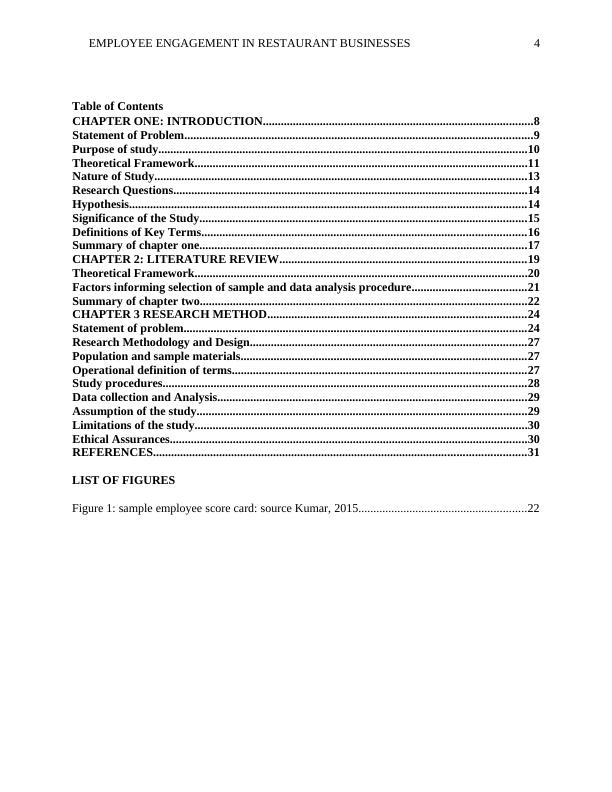
EMPLOYEE ENGAGEMENT IN RESTAURANT BUSINESSES 5
CHAPTER ONE: INTRODUCTION
There are several different factors pertaining to the establishment of modern-day
businesses within the economy. Research has discovered that inside the European Union,
out of the existing firms, ninety-nine percent (99%) are small businesses (Arasti, 2012).
Research disclosures additionally revealed that twenty percent (20%) of recently
established businesses closed down within one year, and sixty-six percent (66%) within
six years while twenty-three percent (23%) of Canadian new businesses were likely to
come up short inside the first year (Arasti, 2012). Within the United States, fifty (50) to
seventy (70) percent of startup businesses shut down within the first twenty-one (21)
months (Danner, 2015). A study over the U.S uncovered that over twenty-three percent
(23%) of restaurant businesses failed in a span of ten years (Parsa, 2014).
More research discovered that thirty four percent (34%) of re-established people
in business had experienced financial disappointments (Ucbasaran, 2010), whereas
exploring a predictive procedure of successful businesses Marom (2014) found out that
nearly half of small businesses fizzled out in a comparative extent of an attempt of
establishment. The analysts found out that angles relating to the measure of money
related record keeping, years of involvement in administration, arranging strategies,
outsourcing of skill, superior staffing, and the age of the commerce proprietors, were
among variables that contributed to the success and failure of recently established
businesses. These findings are a clear sign that commerce disappointment over the first
years and subsequent years is common thus, a stronger understanding of components
driving to such disappointments would offer assistance to practical and feasible business
exploits (Marom, 2014). Despite these discoveries being apparent for the recently
CHAPTER ONE: INTRODUCTION
There are several different factors pertaining to the establishment of modern-day
businesses within the economy. Research has discovered that inside the European Union,
out of the existing firms, ninety-nine percent (99%) are small businesses (Arasti, 2012).
Research disclosures additionally revealed that twenty percent (20%) of recently
established businesses closed down within one year, and sixty-six percent (66%) within
six years while twenty-three percent (23%) of Canadian new businesses were likely to
come up short inside the first year (Arasti, 2012). Within the United States, fifty (50) to
seventy (70) percent of startup businesses shut down within the first twenty-one (21)
months (Danner, 2015). A study over the U.S uncovered that over twenty-three percent
(23%) of restaurant businesses failed in a span of ten years (Parsa, 2014).
More research discovered that thirty four percent (34%) of re-established people
in business had experienced financial disappointments (Ucbasaran, 2010), whereas
exploring a predictive procedure of successful businesses Marom (2014) found out that
nearly half of small businesses fizzled out in a comparative extent of an attempt of
establishment. The analysts found out that angles relating to the measure of money
related record keeping, years of involvement in administration, arranging strategies,
outsourcing of skill, superior staffing, and the age of the commerce proprietors, were
among variables that contributed to the success and failure of recently established
businesses. These findings are a clear sign that commerce disappointment over the first
years and subsequent years is common thus, a stronger understanding of components
driving to such disappointments would offer assistance to practical and feasible business
exploits (Marom, 2014). Despite these discoveries being apparent for the recently
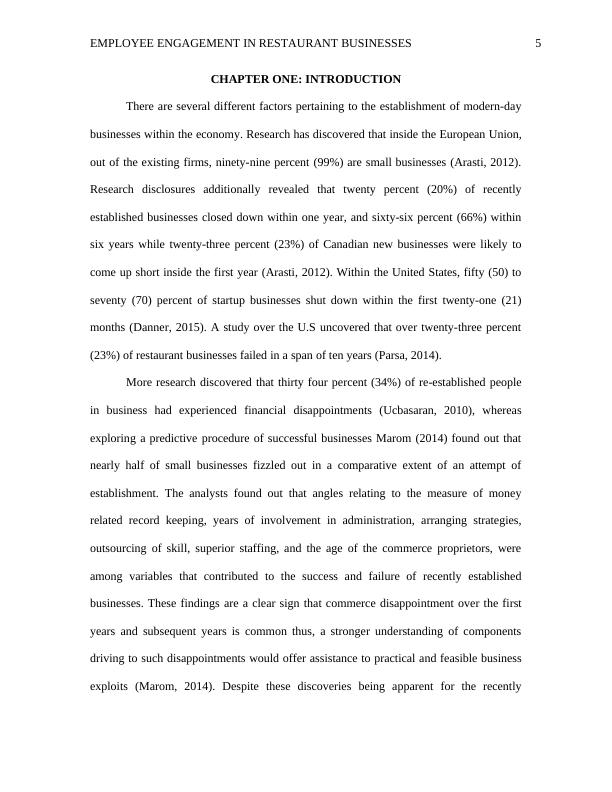
EMPLOYEE ENGAGEMENT IN RESTAURANT BUSINESSES 6
developed businesses, some research has reflected on the failure of restaurant businesses.
Among investigations that have closely related to this area include variables influencing
the failure of eatery businesses.
Statement of Problem
The problem to be addressed by this study is the lack of employee engagement
utilized in modern successful restaurant businesses in the United States. Research finds
that the average failure rates for restaurants are fifty-three-point zero six percent
(53.06%) with in the first five years in business (Healy, 2019). Restaurant failures are a
significant issue in this sector since, based on research, if one were to open a restaurant
business; they would only have forty-six-point nine four percent (46.94%) successful
chance of keeping that restaurant open longer than five years. In spite of all the failures
there is a significant gap in research that aids in the prevention of such failures (Gase,
2019). Several factors can determine the success of a business, such as capital, revenue,
expansion, employee engagement, and other types of business growth factors.
Researchers such as Gase (2019) are asking for more studies in different regions
concerning employee engagement in restaurant businesses. There is a significant
discrepancy in the literature as to which variables help businesses lead to success in
businesses (Lussier, 2010). Other researchers such as Parsa (2014) are seeking this study
to find out what proven concepts such as employee engagement are actually helping
businesses remain successful. Researches have also determined that research demands a
closer look into variables that determine why businesses are successful (Marom, 2014).
In numerous studies, research utilizing employee engagement in businesses is
missing key factors that are required in order to decrease the limitations of the study
developed businesses, some research has reflected on the failure of restaurant businesses.
Among investigations that have closely related to this area include variables influencing
the failure of eatery businesses.
Statement of Problem
The problem to be addressed by this study is the lack of employee engagement
utilized in modern successful restaurant businesses in the United States. Research finds
that the average failure rates for restaurants are fifty-three-point zero six percent
(53.06%) with in the first five years in business (Healy, 2019). Restaurant failures are a
significant issue in this sector since, based on research, if one were to open a restaurant
business; they would only have forty-six-point nine four percent (46.94%) successful
chance of keeping that restaurant open longer than five years. In spite of all the failures
there is a significant gap in research that aids in the prevention of such failures (Gase,
2019). Several factors can determine the success of a business, such as capital, revenue,
expansion, employee engagement, and other types of business growth factors.
Researchers such as Gase (2019) are asking for more studies in different regions
concerning employee engagement in restaurant businesses. There is a significant
discrepancy in the literature as to which variables help businesses lead to success in
businesses (Lussier, 2010). Other researchers such as Parsa (2014) are seeking this study
to find out what proven concepts such as employee engagement are actually helping
businesses remain successful. Researches have also determined that research demands a
closer look into variables that determine why businesses are successful (Marom, 2014).
In numerous studies, research utilizing employee engagement in businesses is
missing key factors that are required in order to decrease the limitations of the study
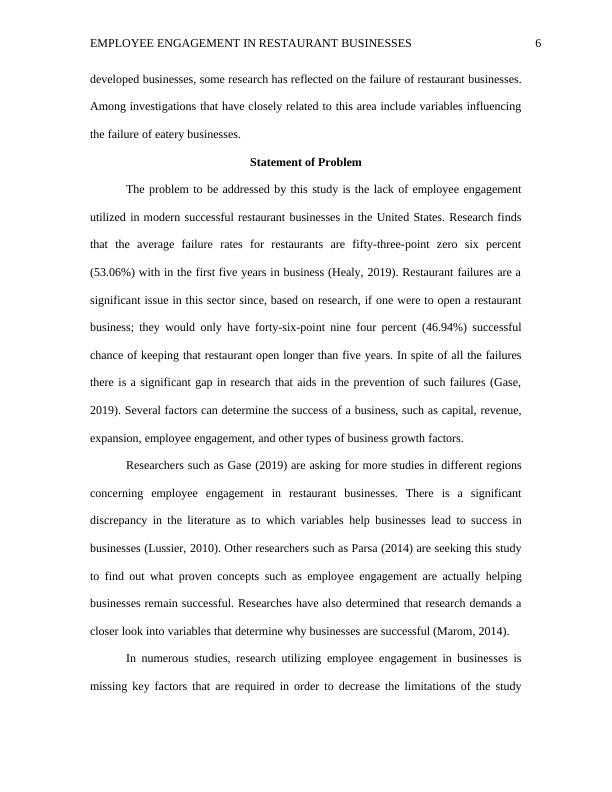
End of preview
Want to access all the pages? Upload your documents or become a member.
Related Documents
Role of motivation in talent management and retention within a UK retail industrylg...
|31
|6290
|308
An investigation on the impact of loyalty scheme on tourist fidelity towards the aviation industrylg...
|64
|19251
|31
62 INDUSTRY RESEARCH PROJECT 62 INDUSTRY RESEARCH PROJECTlg...
|60
|12350
|50
Restaurant Industry in London - Dissertationlg...
|77
|24717
|42
Applying the Principle of Service Designlg...
|52
|12992
|21
The Impact of Social Media and Mobile Technology on the Business Performance of 4Com Plclg...
|34
|6957
|290
